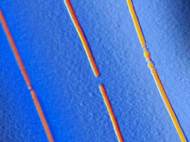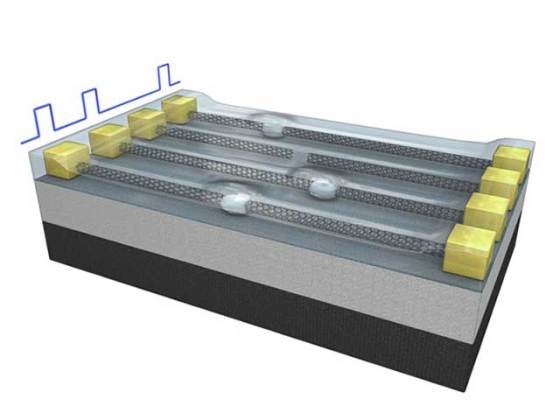Carbon nanotubes used to lower energy consumption used for memory
 In our previous articles, we sporadically mention the need for breakthroughs in energy storing technology and the folks from the University of Illinois have developed a form of ultra-low-power digital memory that is faster and uses 100 times less energy than a similar memory available today. The technology could give future portable devices much longer battery life between charges.
In our previous articles, we sporadically mention the need for breakthroughs in energy storing technology and the folks from the University of Illinois have developed a form of ultra-low-power digital memory that is faster and uses 100 times less energy than a similar memory available today. The technology could give future portable devices much longer battery life between charges.
“I think anyone who is dealing with a lot of chargers and plugging things in every night can relate to wanting a cell phone or laptop whose batteries can last for weeks or months”, said Eric Pop, lead researcher professor of electrical and computer engineering who is also affiliated with the Beckman Institute for Advanced Science and Technology at Illinois.
The flash memory used in mobile devices today stores bits as charge, which requires high programming voltages and is relatively slow. Industry has been exploring faster, but higher power phase-change materials (PCM) as an alternative which relies on switchable resistance of the material, which is switchable. Pop’s group, lowered the power per bit to 100 times less than existing PCM memory. Instead the metal wires, the group used carbon nanotubes.
“The energy consumption is essentially scaled with the volume of the memory bit”, said Feng Xiong. “By using nanoscale contacts, we are able to achieve much smaller power consumption.”
To create a bit, the researchers place a small amount of PCM in a nanoscale gap formed in the middle of a carbon nanotube. They can switch the bit “on” and “off” by passing small currents through the nanotube. Nanotubes also boast an extraordinary stability, as they are not prone to the degradation that can affect metal wires. In addition, the PCM that functions as the actual bit is immune to accidental erasure from a passing scanner or magnet.
“Anytime you’re running an app, or storing MP3s, or streaming videos, it’s draining the battery”, said Albert Liao, a graduate student and co-author. “The memory and the processor are working hard retrieving data. As people use their phones to place calls less and use them for computing more, improving the data storage and retrieval operations is important.”
The low-power PCM bits could be used in existing devices with an increase in battery life. Although it lowers energy consumption, there is a need for breakthroughs in display and processing technologies. The low-power memory could also enable three-dimensional integration, a stacking of chips that has eluded researchers because of fabrication and heat problems. The team has made and tested a few hundred bits so far, and they want to scale up production to create arrays of memory bits that operate together. They also hope to achieve greater data density by programming it as a multibit memory where each physical PCM bit can program two data bits.
“Even though we’ve taken one technology and shown that it can be improved by a factor of 100, we have not yet reached what is physically possible. We have not even tested the limits yet. I think we could lower power by at least another factor of 10”, said Pop.
For more information, read the research paper named: “Low Power Switching of Phase-Change Materials with Carbon Nanotube Electrodes”.










Excellent Technology.
Dr.A.Jagadeesh Nellore(AP),India